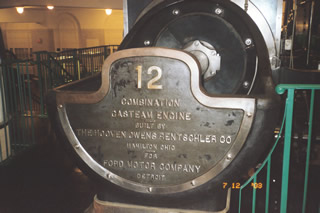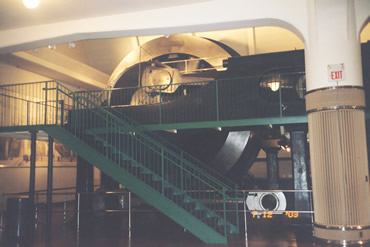In addition to a nice collection of old cars, which I expected, The Henry Ford Museum in Dearborn, MI had an amazing collection of steam-powered and early electricity generating engines that FAR surpassed anything on exhibit at the Smithsonian Museum of American History. The museum even has part of the steam-powered electricity generation setup used to power the Rouge Factory in Ford’s day. This consisted of 2 of the 12 gas/steam powered pistons that turned huge wheels, maybe 15 feet high? The placard said that Ford brought the machinery to the site, then built the museum around it, which I believe because it was massive!


One disappointment I had with the curation for the steam and electricity displays was that the link was never made between the need to use steam power to turn a wheel, and the generation of electricity. (I saw the same gap in the explanations of Edison’s early electricity generating station in Greenfield Village.)
The Dymaxion House
Another display that was fun was the original aluminum-domed “house of the future”—called the Dymaxion House--designed by Buckminster Fuller in the 1920’s and offered as a solution to the post-WWI housing shortage. The house was proposed as a low-cost way to meet the housing needs of returning G.I.’s, and one that could be taken apart and moved to a new location as the occupants moved. Another marketing angle for the house was that it could be manufactured by aircraft manufacturers using aluminum skin technology developed for the war, and would provide continuing employment for workers at those factories.
Apparently only 2 prototypes were built, and despite having a number of orders, none were ever produced. The design seemed very ahead of its time, with rainwater recapture to a cistern for watering plants and gardens, overhead lighting with soft colors that could be altered to change the mood of the rooms, a passive ventilation system including a roof vent and outer wall panels that opened, and built-in closets and rotating shelves to save floor space and reduce clutter. The design incorporated the latest materials, including metal surfaces (with rounded corners for easy cleaning) and Naugahyde wall panels. The museum guide also pointed out that having 2 bathrooms was revolutionary in an era when nearly half of homes had no indoor “facilities” at all! (Side note: in checking the spelling of Naugahyde, I found the very cute website about the product and the history—-still made in USA!)
Stephanie, Webmaster
StillMadeinUSA.com
4 comments:
why do your photos have a 2003 date on them?
Response to Anonymous: because I am not smart enough to figure out how to reset the camera date function!? :)
My grandfather worked for the man who designed that huge power plant that's on display at the Ford Museum. That power plant was actually at Highland Park. Edward Gray was the designer. He sold Ford the first three power plants from his Riverside Engine Company in Oil City, PA, where my grandfather first worked for Gray. Ford hired Gray as his chief engineer in 1909 and my grandfather joined him in 1910, living at his home until he got a place of his own. See more at https://www.flickr.com/gp/rushhourphoto/i92M27
Yes, you are right about them building the museum around the massive gas-steam power plant engine saved from the Highland Park Power Plant building. There would be no way they could bring and assemble that engine into the museum once the teak floors were laid. Even then they came within six inches of the ceiling installing it. The flywheel weights 100 tons and is in two parts. Two nearly one ton 'keys' hold it together. They had to be heated 'cherry red hot' to insert them and as they cooled, that's what drew the two halves together tightly. This was nearly a year long job, to disassemble then reassemble the engine. One sign there states it was built in 1912 but this one was later, more like 1916, as the power plant building that it was originally in wasn't completed until 1915 or so. My grandfather worked as a draftsman for the designer, Edward Gray, first in Oil City, PA starting in 1906, where the first 'gas only' 1500hp engine was built. Next was a 5000hp 'gas steam' engine before eight other engines were built like the one in the museum. The end plate on the 5000hp engine clearly shows that Gray was the designer- some sources show William Mayo as the designer but he was the salesman for the company that built them- to Gray's design specs. Edward Gray was Henry Ford's Chief Engineer from 1909 to 1914. He also was responsible for the design and layout of the power plant building and other floor plans at Highland Park, as noted in Charles Sorensen's book, My Forty Years With Ford, page 125- "Edward Gray, the company's construction engineer, whipped these layouts into floor plans and building dimensions. Supplied with this material, Architect Albert Kahn then made the detailed plans and specifications."
When Gray left Ford in August of 1914, Mayo did take the job of Chief Engineer but it was Gray who did the foundational work and design for most of the Highland Park Plant and the nine engines used there. You can read much more about the job of moving that engine and the procurement of the other items there in The Reminiscences of Mr. Roy Schumann http://cdm15889.contentdm.oclc.org/cdm/search/collection/p15889coll2/searchterm/The%20Reminiscences%20of%20Mr.%20Roy%20Schumann/order/nosort
Post a Comment